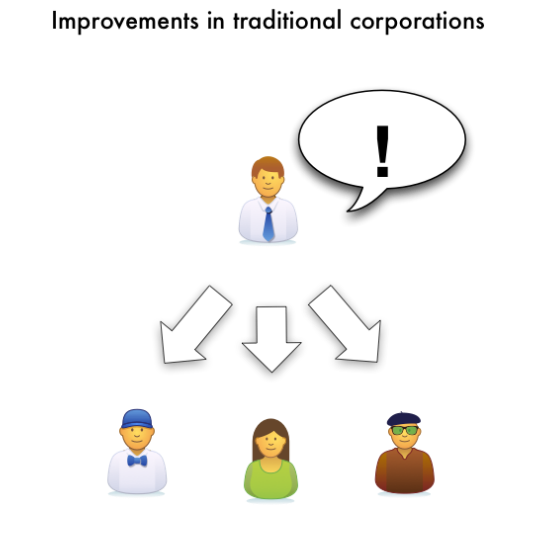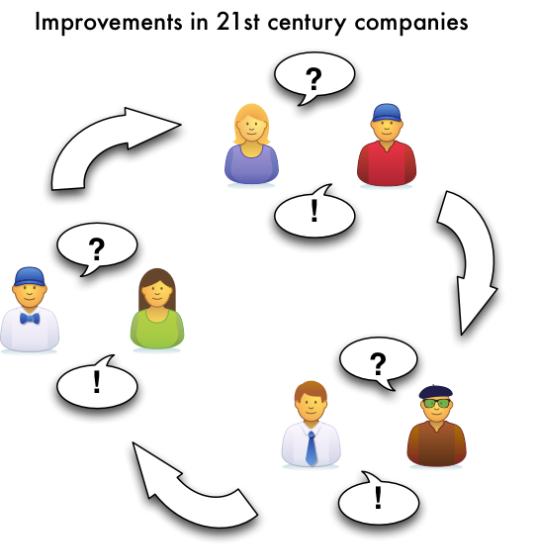With companies like Google, Amazon, Basecamp, Spotify, Netflix and Valve re-defining the markets and the whole game in IT and related fields, more traditional corporations have had hard time to stay in the competition.
This has lead to many organizational reforms and process roll-outs in these corporations. With less than remarkable results.
What are these new companies doing differently to stay ahead?
1. They assume they do not know everything

In traditional corporations the attitude towards knowledge is static and closed to outside.

21st century companies aim to create knowledge by interacting with their environment.
In traditional corporations, everybody is hired on the assumption that their expertise means that they know everything necessary to carry out their jobs. Product managers know what kind of products should be built to ensure success, developers know what technologies to use and managers know how to lead a corporation.
In the 21st century companies, the approach to knowledge is different. Yes, people most close to the work are deemed the experts. But even at their areas of expertise, it is taken for granted that most important things start as unknowns. The most important attribute of people in these new companies is not that they know everything, but that they are able to gather and learn the needed knowledge as part of their work.
In traditional corporations, revealing ignorance is seen as a weakness in any member of a corporation and can result in sanctions. There is no discussion on what the company should learn as it is assumed that everything important is already known. The mindset is that success is a result of creating a perfect plan and following it rigorously. When there are important shortage of knowledge inside the corporation, it remains hidden.
Instead of hiding ignorance the cutting-edge companies support transparency of ignorance and reward work that brings new knowledge. That means that most of the work is systematic creation of new knowledge. In other words, systematic experimentation. Experiments that create more knowledge about their operating environment. And because ignorance is not a taboo, these experiments are discussed by everyone and their learnings are spread to the whole organization.
2. They involve everyone in the improvement work

In traditional corporations the management designs and rolls out the improvements.

In 21st century companies, everybody is responsible for improvement work.
The work of improving organizations is left to managers in a traditional corporation. They plan new organization structures and new work processes and are responsible for rolling out these changes. Managers are hired based on their experience. The corporations assume that experience leads to them being able to choose the right change initiatives to undertake. In fact, if a manager says that he or she does not know the right course of action, he is deemed incompetent.
In the cutting-edge companies, everybody is responsible for making the organization and ways of working better. Anyone can start an experiment to try to improve the ways of working.
The difference is staggering. Even if the motivational and systems thinking related benefits are left out of the equation, you can probably picture the difference of 5 C-suite managers being the only source of all improvements to everybody in the (for instance, 10000 people) organization coming up with possible innovations to improve ways of working.
3. They experiment in product development
Traditional corporations excel in squeezing out every penny of profit from the markets that they are in. They know the markets they operate in and can use that knowledge efficiently by planning marketing campaigns and optimizing processes to increase profits by minimizing production and customer acquisition costs.
And because they excel in operating in those existing markets, that is where they invest in. What they struggle in is creating new markets and creating products that disrupt the existing markets. The corporations often try to use the same mode of operation for this as in existing markets: establishing a goal and then laying out a careful plan how to achieve that goal. It is assumed that every piece of knowledge needed to lay a winning plan can be found inside the corporation.
This approach has often resulted in the corporations wasting a lot of money to launch new products that do not perform that well. That has resulted in hesitation to invest in new ventures in many corporations.
Cutting-edge companies, on the other hand, listen to potential customers and explore to whole marketplace for potential new markets and business opportunities. Using methods like Customer Development, Lean Startup, Design Thinking, Service Design and Lean UX they form hypotheses for new products and markets and experiment on them to validate those hypotheses. They do this with using the minimum resources possible to see if the new product idea is viable. They will also kill new product development endeavors right away if they prove to be not viable.
This means that the cutting-edge companies will find emerging markets earlier than traditional corporations and an stake claim to them before their competition. They also learn continuously about their customer segments and their needs, enabling them to develop more attractive products in the future even if some of their experiments fail (and most of them fail, naturally). All this while using less money on exploring new ventures.
4. They experiment in finding new ways of working
Traditional corporations aim for applying best practices in their organization. They believe that the best way of organizing the work is known already and the challenge is to get the organization comply with it.
With best practices, industry standard becomes the glass ceiling of your organization’s effectiveness. Discovering new better ways of doing things removes that limit.
The cutting-edge companies focus on just that: discovering the next practices. They believe that there are always ways to improve the ways of working and that their unique circumstances mean that no defined process or framework will fit them perfectly. So they make small experiments to find out how to organize their work to have the maximum impact.
Traditional corporations try to have every part of the organization comply with the same set of best practices. That is the logical course of action if these best practices suit every situation and environment.
Cutting-edge companies acknowledge that the best way of doing something in one team might not be the best for another. So they allow teams and individuals to interpret the results of other’s experiments themselves. By that they allow teams to adapt to their environment. In the ever-changing business landscape of te digital era, the adaptability itself is an essential property of organizations and their teams.
5. They experiment with management and organization
In traditional corporations, the matrix structure is ever-present. If an organizational reform is made, the end result is a different kind of matrix below the C-suite level. The different configurations of the matrix are usually just a minor tweaks to the existing system of doing work, however. In many cases the employees of a corporation report that very little has changed in how work is actually done after an organization reform.
In cutting-edge companies, the role of management, organizational structures and even the C-suite is questioned. At Valve, employees decide which product team they want to work in. At Treehouse, middle management was abolished and all employees were encouraged to become servant leaders for each other. At Spotify, managers and coaches serve their tribes, guilds and squads (which consist of employees) instead of the employees reporting to the managers.
Most of these started as an experiment. One such experiment is our #NoEmployees approach to organization structure and division of responsibility and power. The effects on these experiments on how the work is done and what impact they have on the results of work are measured throughout the experiments. This allows the cutting-edge companies to find out what changes to organization and management make them better. They can then stick with those changes and end the failed experiments before they become costly.
As Einstein said: the definition of insanity is doing the same thing over and over and expecting different results. Cutting-edge companies get that based on their approach to management and organization structures. Traditional corporations fail in this. This is one of the reasons for them being unable to compete with the cutting-edge 21st century companies.
Conclusion
One word is repeated over and over in each of the preceding paragraphs: experiment. That seems to be the defining term for cutting-edge 21st century companies like Google, Amazon, Basecamp, Spotify, Netflix and Valve.
Experiments are needed when we operate in complex domains. In complex domains we do not know beforehand which approach will have the desired impact. That is true for product development, improvement of ways of working and organization design in the 21st century.
That is also why we at Flowa take experimentation very seriously. We constantly seek better products and business models, better ways of working and better ways of organizing ourselves to maximize our impact.
What are you doing to learn more and improve in your organization? What kind of experiments do you think of running next? Please tell us in the comments below.
The heading image of this post is Lemonade stand by C.J.Peters.
